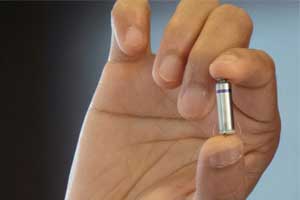- Home
- Editorial
- News
- Practice Guidelines
- Anesthesiology Guidelines
- Cancer Guidelines
- Cardiac Sciences Guidelines
- Critical Care Guidelines
- Dentistry Guidelines
- Dermatology Guidelines
- Diabetes and Endo Guidelines
- Diagnostics Guidelines
- ENT Guidelines
- Featured Practice Guidelines
- Gastroenterology Guidelines
- Geriatrics Guidelines
- Medicine Guidelines
- Nephrology Guidelines
- Neurosciences Guidelines
- Obs and Gynae Guidelines
- Ophthalmology Guidelines
- Orthopaedics Guidelines
- Paediatrics Guidelines
- Psychiatry Guidelines
- Pulmonology Guidelines
- Radiology Guidelines
- Surgery Guidelines
- Urology Guidelines
Novel leadless pacemaker has less complications

Patients receiving leadless cardiac pacemakers (LCPs) experience overall fewer short-term and mid-term complications than those receiving traditional transvenous pacemakers (TVPs), finds a study published in the journal Heart Rhythm.
Daniel J. Cantillon, research director for Cardiac Electrophysiology and Pacing at Cleveland Clinic, Cleveland, Ohio, and colleagues conducted the study to compare complications between the LCP cohort from the LEADLESS Pacemaker IDE Study (Leadless II) trial and a propensity score-matched real-world TVP cohort.
Approximately one million pacemakers are implanted annually, providing electrical stimulation to regulate a patient's heartbeat.
Conventional pacemakers are surgically placed under the skin of a patient's chest, with wires, or leads, stretching from the shoulder vein and attaching to the heart. These wires and the surgical implantation are the most common source of complications, occurring in up to 12 percent of device recipients, according to previous research.
Leadless pacemakers, by contrast, do not need wires. The small self-contained devices - about 10 percent of the size of a traditional pacemaker - are placed directly into the heart using a catheter passed through the femoral vein in the leg. Leadless pacemakers were introduced in 2014, and the first leadless pacemaker was approved by the FDA in 2016.
The new multi-center study compared short- and mid-term complications between 718 patients receiving the Nanostim leadless pacemaker and 1,436 patients with conventional (transvenous) pacemakers. Leadless pacemaker patient data was taken from the LEADLESS II trial, a prospective, nonrandomized, multicenter clinical trial. Transvenous patient data were obtained from Truven Health MarketScan claims databases for patients implanted with single-chamber pacemakers between April 2010 and March 2014 and more than 1 year of pre-implant enrollment data. Statistical methods were used to match patients between the two groups to compare the outcomes of a leadless vs. traditional pacemaker with other key clinical variables being equal.
Key Findings:
- At one month, the study found that patients receiving one type of leadless pacemaker (Nanostim) overall had fewer complications (5.8 percent vs. 9.4 percent).
- Leadless pacemakers completely eliminated lead and pocket complications, including infection.
- By comparison, complications among traditional pacemaker recipients included lead complications (3.62 percent), pocket complications (0.42 percent) and infection (1.74 percent).
- There were no significant differences between the groups in regard to rates of vascular complications, electrode dislodgement, and generator complications.
- However, the study did find that those receiving leadless pacemakers had an increased risk of developing pericardial effusion - bleeding between the heart and the sac that surrounds the heart (1.53 percent vs. 0.35 percent). These complications were uncommon but serious and sometimes required surgery.
- Beyond one month and up to 18 months of follow-up, leadless patients continued to experience overall fewer complications than transvenous patients (0.56 percent vs. 4.94 percent).
- In the conventional pacemaker group, there were a number of complications wholly absent from the leadless group, including lead-related complications, electrode dislodgement, infection and pocket complications.
"The data from this study is encouraging, and we expect complications from leadless pacemakers to continue to decline as the technology improves and physicians gain experience implanting these devices," said Dr. Cantillon. "While this research shows benefit for leadless pacing, we must keep in mind that the field is still too young to compare the long-term results of this technology, the implications of which will not be fully understood for at least another decade."
Based on the study, the authors concluded that patients with LCPs experienced fewer overall short- and mid-term complications, including infectious and lead- and pocket-related events, but more pericardial effusions, which were uncommon but serious.

Disclaimer: This site is primarily intended for healthcare professionals. Any content/information on this website does not replace the advice of medical and/or health professionals and should not be construed as medical/diagnostic advice/endorsement or prescription. Use of this site is subject to our terms of use, privacy policy, advertisement policy. © 2020 Minerva Medical Treatment Pvt Ltd